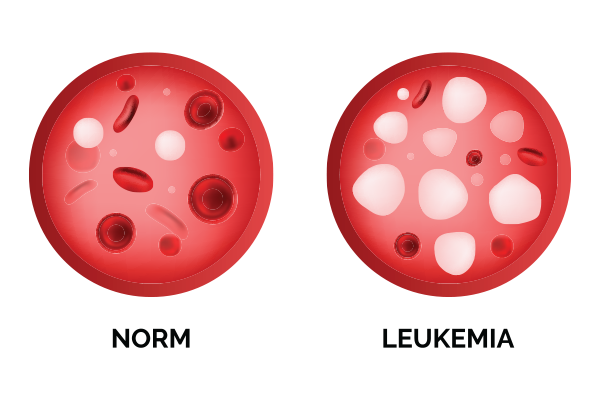
Leukaemia is a serious condition that affects thousands of individuals across the world each year, including many in India. As a blood cancer, it can progress rapidly or slowly, and early detection can significantly improve outcomes. Understanding what the early symptoms of leukaemia are, the types of leukaemia, and the available leukaemia treatment options can make all the difference.
At Manipal Hospital Baner, we are committed to providing cutting-edge diagnosis and treatment for leukaemia patients, backed by a team of experienced haematologists and oncologists. This guide will help you understand the key signs, symptoms, and types of this complex disease.
Synopsis
What Is Leukaemia?
Leukaemia is a type of cancer that begins in the bone marrow, the soft tissue inside your bones where blood cells are produced. It leads to the overproduction of abnormal white blood cells, which interfere with the body’s ability to produce healthy red cells, platelets, and infection-fighting white cells.
There are multiple types of leukaemia, and each one behaves differently. Some develop suddenly and progress quickly, while others take years to show noticeable symptoms.

Types of Leukaemia
Leukaemia is grouped into four primary types, each with distinct characteristics:
1. Acute Lymphoblastic Leukaemia (ALL)
-
Most common in children, but can occur at any age
-
Rapid progression
-
Affects immature lymphoid cells
-
Often requires aggressive and immediate treatment
2. Acute Myeloid Leukaemia (AML)
-
More common in adults but can affect children
-
Rapid progression
-
Affects myeloid cells which develop into red cells, white cells, and platelets
-
Requires urgent medical intervention
3. Chronic Lymphocytic Leukaemia (CLL)
-
Usually affects adults over 60
-
Slower progression
-
May not present symptoms for several years
-
Can be monitored until treatment is needed
4. Chronic Myeloid Leukaemia (CML)
-
Primarily seen in adults
-
Starts slowly, can enter a faster-growing phase
-
Associated with a genetic mutation (Philadelphia chromosome)
-
Treated effectively with targeted therapies
If you suspect any signs or symptoms, experts at Manipal Hospital Baner can conduct comprehensive tests to accurately determine the type and stage of leukaemia.
What Are the Early Symptoms of Leukaemia?
One of the most crucial steps in fighting leukaemia is recognising it early. But what are the early symptoms of leukaemia? Many of these signs are general and can be mistaken for other illnesses, which is why it’s essential to stay alert.
Common early symptoms include:
-
Unexplained fatigue or weakness
-
Frequent infections or fevers
-
Easy bruising or bleeding
-
Pale skin
-
Shortness of breath
-
Swollen lymph nodes (especially in the neck or armpits)
-
Night sweats
-
Loss of appetite or unintended weight loss
-
Bone or joint pain
Skin leukaemia symptoms such as red or purple rashes, petechiae (small pinpoint red spots), and skin nodules.
Skin leukaemia symptoms can sometimes be the first visible signs, especially in certain types like leukaemia cutis, where leukaemia cells infiltrate the skin.
If you notice any combination of these symptoms, especially if they persist, schedule an appointment with a specialist at Manipal Hospital Baner for evaluation.
How Is Leukaemia Diagnosed?
Accurate diagnosis is the first step toward effective leukaemia treatment. At Manipal Hospital Baner, diagnosis may involve:
-
Complete Blood Count (CBC) – to detect abnormal levels of white cells, red cells, and platelets
-
Peripheral blood smear – to examine the shape and maturity of cells
-
Bone marrow biopsy – to confirm the presence and type of leukaemia
-
Cytogenetic tests – to detect chromosomal abnormalities (e.g., Philadelphia chromosome in CML)
-
Flow cytometry and molecular testing – for deeper analysis of blood and marrow cells
Leukaemia Treatment Options
Once the diagnosis is confirmed, a personalised treatment plan is created based on the type of leukaemia, age, health condition, and stage of the disease. The main options for leukaemia treatment include:
1. Chemotherapy
-
The most common treatment
-
Involves powerful drugs to kill cancerous cells
-
Can be given orally or intravenously
-
Usually given in cycles with rest periods
2. Targeted Therapy
-
Specifically attacks cancer cells without harming normal cells
-
Particularly effective for CML and some subtypes of ALL
-
Example: Tyrosine kinase inhibitors (TKIs) for Philadelphia chromosome-positive leukaemia
3. Immunotherapy
-
Boosts the immune system to fight leukaemia cells
-
Includes monoclonal antibodies and CAR-T cell therapy in advanced centres
4. Radiation Therapy
-
Not commonly used but may be helpful for certain areas like the brain or spleen
-
Can shrink tumours or prepare the body for a bone marrow transplant
5. Stem Cell or Bone Marrow Transplant
-
Replaces diseased bone marrow with healthy cells
-
Often used in relapsed or high-risk cases
-
Requires a compatible donor and specialised care
Manipal Hospital Baner offers all advanced treatment modalities with multidisciplinary support to ensure the best outcomes for patients.
Living With Leukaemia: Ongoing Care and Support
Leukaemia is a life-changing diagnosis, but with the right support, many people live long and fulfilling lives. Chronic forms like CLL may not need immediate treatment but require regular monitoring. Acute forms often demand more aggressive treatment and frequent follow-ups.
At Manipal Hospital Baner, we offer:
-
Nutritional guidance
-
Infection prevention strategies
-
Emotional and psychological support
-
Access to leukaemia support groups
-
Rehabilitation and survivorship programmes
Why Choose Manipal Hospital Baner?
Manipal Hospital Baner stands out for its comprehensive, patient-centric cancer care. From early detection to cutting-edge leukaemia treatment, our facility is equipped with the latest medical technologies and a compassionate care team.
We provide:
-
Expert haematologist
-
24/7 emergency care and supportive services
-
Advanced laboratory and imaging diagnostics
-
Multidisciplinary tumour board reviews for complex cases
-
Personalised treatment plans and holistic support
Conclusion
Leukaemia can be daunting, but knowledge is your first line of defence. Being aware of what the early symptoms of leukaemia are, understanding the types of leukaemia, recognising skin leukaemia symptoms, and knowing your treatment options are crucial steps in fighting this disease.
If you or your loved one are experiencing any symptoms mentioned above, don’t delay. Reach out to our cancer specialist in Baner for timely diagnosis and comprehensive care.
Your health and well-being are our top priorities.
FAQ's
Early symptoms of leukaemia may include fatigue, frequent infections, unexplained bruising or bleeding, night sweats, weight loss, swollen lymph nodes, and persistent fever. If you experience these signs, consult a haematologist at Manipal Hospital Baner for prompt evaluation.
Yes, skin leukaemia symptoms can include petechiae (small red spots), ecchymosis (large bruises), and leukaemia cutis (red or purple nodules). These may be early signs of blood cancer and should be examined by a specialist at Manipal Hospital Baner.
The four major types of leukaemia are:
-
Acute Lymphoblastic Leukaemia (ALL)
-
Acute Myeloid Leukaemia (AML)
-
Chronic Lymphocytic Leukaemia (CLL)
- Chronic Myeloid Leukaemia (CML)
Each type differs in progression, age group affected, and treatment strategy.
Diagnosis involves blood tests (CBC), bone marrow biopsy, immunophenotyping, and genetic testing. Manipal Hospital Baner offers advanced diagnostic facilities for accurate subtyping and personalised treatment planning.
Leukaemia treatment depends on the type and stage and may include chemotherapy, targeted therapy, immunotherapy, radiation, or stem cell transplantation. At Manipal Hospital Baner, treatment is customised for each patient using the latest protocols.
Yes. Chronic forms like CLL and CML may not show symptoms for years and are sometimes detected incidentally through routine blood tests. Regular checkups at centres like Manipal Hospital Baner can help catch these cases early.
Most Leukaemias have high cure rates. Others can be managed effectively with long-term treatment. Early diagnosis and access to expert care—such as at Manipal Hospital Baner— can greatly improve outcomes.






















 5 Min Read
5 Min Read

















